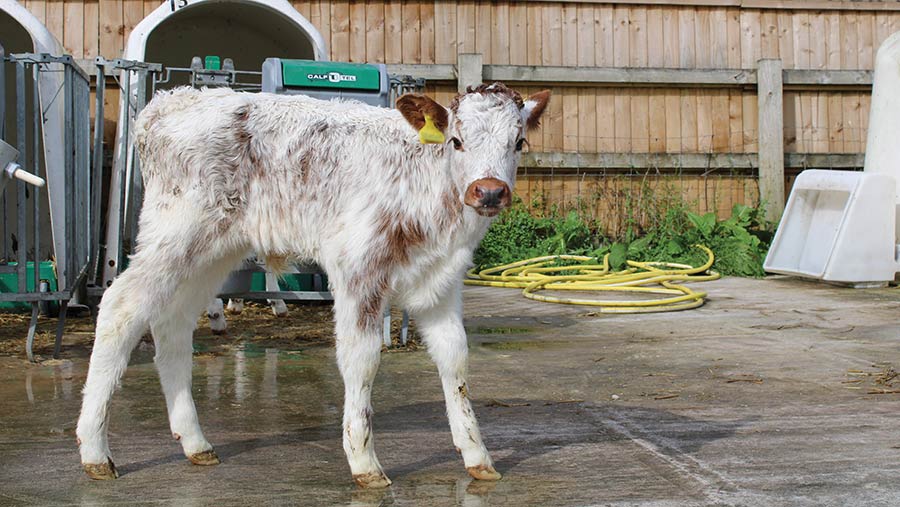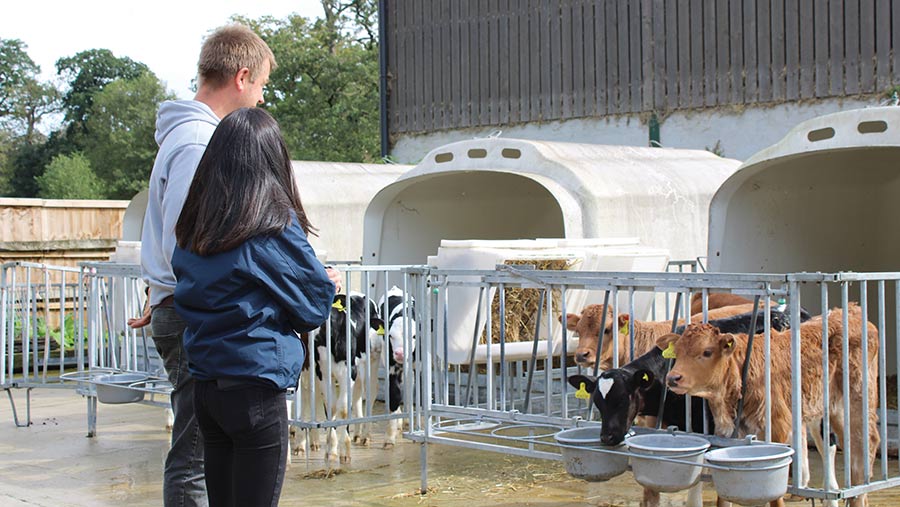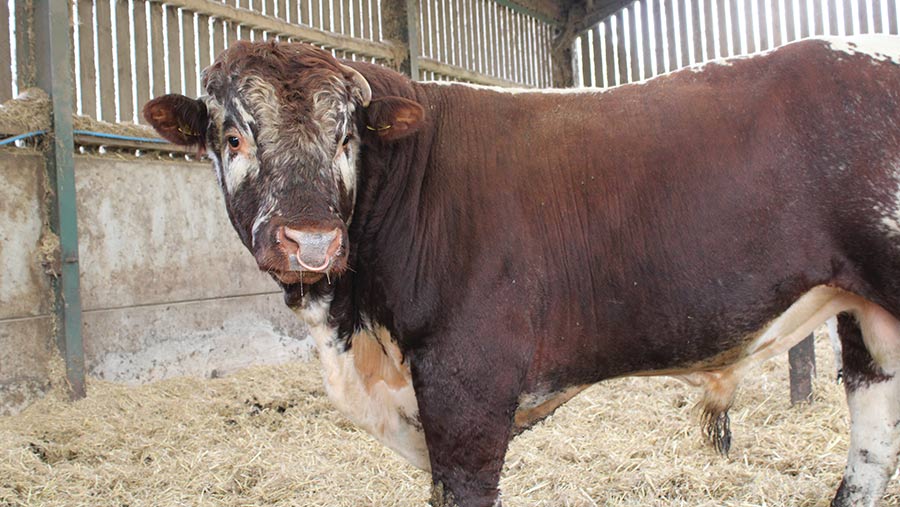Bovine TB blow prompts Welsh dairy farmer to join Longhorn scheme
 Longhorn-cross dairy calf © Brittany McClean/Buitelaar
Longhorn-cross dairy calf © Brittany McClean/Buitelaar Price security and the ability to better weather a bovine TB outbreak were the main reasons dairy farmer Jonathan Scott signed up to a Longhorn scheme.
In 2016, TB hit the business hard, forcing Jonathan, who farms with his wife, Emma, and parents, David and Pauline, to rethink every aspect of the business at Hanmer Mill Farm, Wrexham.
At the time, they were running a flying herd, putting all cows to Simmental stock bulls and selling calves at market at about three to four weeks old. The disease outbreak brought the whole system into question.
See also: Why dairy beef is set to beat arable returns
“A TB market is a bit hit and miss,” says Jonathan. “When we had Simmental calves and were trying to shift them under licence, we really struggled. They were offering us £30 for a nine-week-old calf.”
Farm facts: Hanmer Mill Farm, Wrexham
- 119ha of grass, and 49ha of maize grown on contract for the farm
- 250 Holstein cows
- Calves from 1 September to end of December, aiming for a 12-week block
- 8,630 litres a cow a year at 4.1% fat and 3.6% protein
- Supplies Arla on an Arla Care contract
- Sexed Holstein semen used to rear 80 replacements followed by male sexed Longhorn semen
- Herd grazes paddocks rotationally as soon as conditions allow
- 25-month average age at first calving

Buitelaar’s Jade Toone and Jonathan Scott looking at Longhorn-cross calves © Brittany McClean/Buitelaar
Premium
By contrast, Buitelaar’s Longhorn premium looked an attractive option.
The scheme pays a guaranteed fixed price for a healthy Longhorn-cross weighing more than 55kg – £240 for bulls and £160 for heifers.
And, as part of the contract, Buitelaar promises to take calves from TB-restricted herds all year round, with a 50% price reduction.
This setup appealed to Jonathan: “It’s the security and the planning. You know what you’re going to get and where they’re going,” he says.
At about the same time, the Scotts decided to rear their own replacements to reduce the TB implications of buying in. “We’ve now built the business around TB,” he explains.
Today, the autumn-calving Holstein herd is artificially inseminated with dairy sexed semen until 80 replacements are confirmed.
The remaining cows are served with Longhorn semen. A Longhorn stock bull is run with the heifers and as a sweeper.
As part of the Buitelaar contract, all bulls must be registered with the Longhorn Society (see “Longhorn integrated supply chain”).
Since joining the scheme, the selection of Longhorn sires has widened, and sexed beef semen has become available.
As a result, from January, Jonathan hopes to have 95% bulls produced to attract the higher premium.
Calf rearing
Beef calves are reared in the same way as replacements.
Calves are housed in individual hutches for the first seven days and receive six litres of colostrum within the first 12 hours of birth.
They are then fed on their dam’s milk for the first three days before moving to calf milk replacer, which they receive twice daily at 3 litres a feed. They are also provided with an 18% starter pellet.
The contract does not make any demands about milk or concentrate feeding, but does stipulate good colostrum management.
Generally, calves receive their dam’s colostrum, but if they are born in the night, they will be fed frozen stocks.
“We test every bit of colostrum, and if it [the quality] is not above 22% [on the refractometer] we won’t feed it,” Jonathan explains.
The farm’s vet also routinely carries out total blood protein testing to establish immunoglobulin absorption, which is a reflection of colostrum quality and the success of passive transfer.
Jonathan says good management is essential to ensure calves are well grown to meet the contract requirement of weighing more than 55kg at 15-41 days old.
This means they need to achieve an average daily liveweight gain of more than 0.4kg, based on a birthweight of 35kg for heifers and 40kg for bulls.
That is helped by selecting sires with good growth rates, as well as easy-calving traits.
At Hanmer Mill Farm, Longhorns average a daily liveweight gain of 0.6kg, with the best of the most recent batch achieving 0.97kg/day, and leave at 36-38 days old, on average.
A Buitelaar buyer will visit the farm to select calves. These are then graded at the collection centres.
“We have to do it right, not just for Buitelaar, but for our milk contract,” says Jonathan.
Under the terms of his Arla Care contract, he must have a cow and calf mortality rate of less than 5%, with calves not being slaughtered under 57 days of age.
The Longhorn scheme gives him the reassurance that calves will continue to be reared once they leave the farm.
Calving ease
The Longhorns have also proved to be easy-calving: last year, only 2% of about 150 Longhorn births were assisted. This has also resulted in fewer health problems.
“I’m seeing fewer retained membranes and dirty cows. Both of them are under 1%,” he says, adding he has seen improvements in fertility in the milking herd, which he puts down to fewer problems at calving.
The calves themselves are also lively and thrifty as soon as they are born. “We love them; they’re so easy to work with,” he says.
All in all, Jonathan believes the Longhorn scheme has put the business in a stronger position.
“We’re trying to make the business as easy as possible from a TB and lifestyle perspective,” he says.
Longhorn integrated supply chain
Buitelaar has an integrated supply chain, which starts with the dairy farmers that produce the Longhorn calves and carries through to the premium beef markets it supplies.
Beef is sold under Buitelaar’s high-end meat brands, including Prumpelstown Estate.
Longhorn beef is favoured for its marbling, succulence, tenderness and rich flavour, as well as its heritage story as one of England’s oldest breeds.
Main requirements for dairy producers
- Produce fit and healthy Longhorn-cross weighing more than 55kg at 15-41 days old
- A colostrum management programme must be in place
- Use only registered Longhorn sires. Stock bulls must be approved by Buitelaar
- Semen can only be used from approved sires via Cogent, Genus or Semex
- Minimum daily liveweight gain of 0.4kg
- Dams must weigh more than 600kg (not suited to systems with Jersey-cross or New Zealand-style cows)

Longhorn stock bull © Brittany McClean/Buitelaar
The chain
- Jonathan Scott takes calves from Hanmer Mill Farm to the collection centre in Wrexham every Monday
- Calves then go to one of 17 rearers before moving to dedicated finishing units
- Calves are slaughtered at an abattoir in Spalding, with meat going to high-end restaurants and exported throughout Europe
